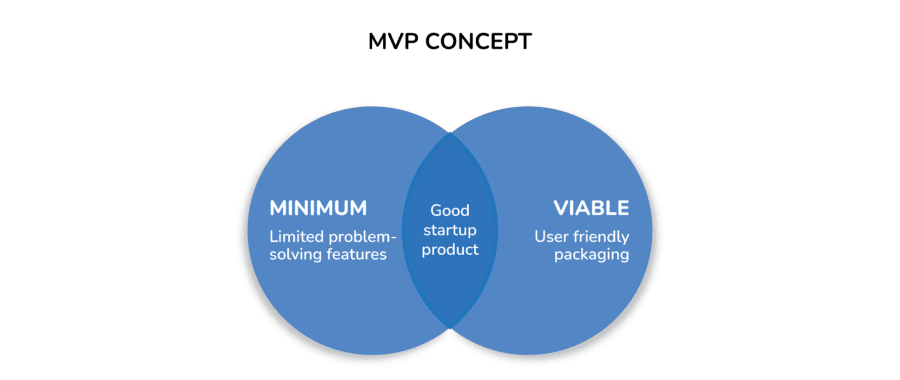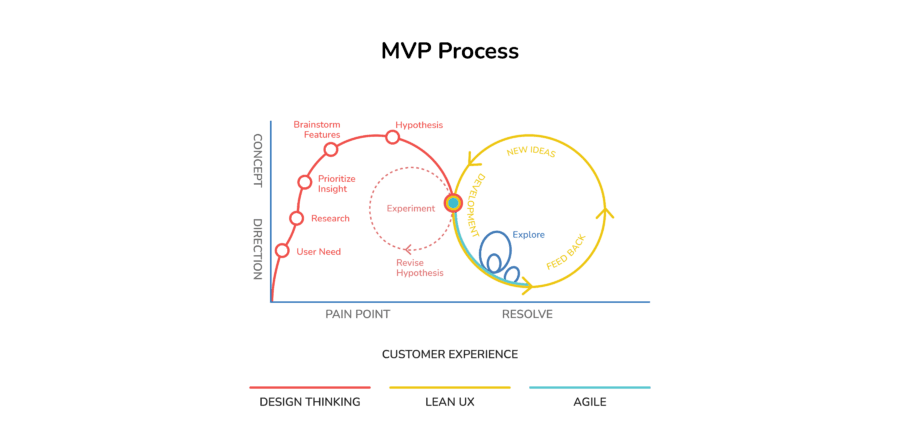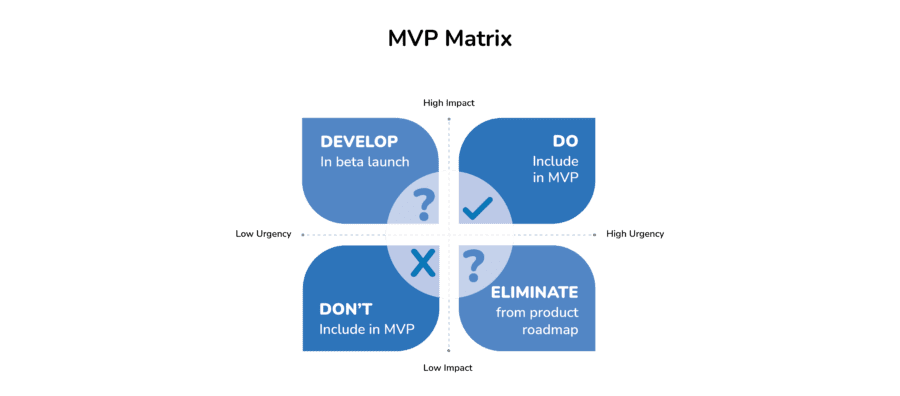
Almost all Software-as-a-Service (SaaS) businesses start with a “visionary idea” – a concept that can revolutionize the industry. Yet, the world has witnessed numerous passionate founders invest their energy, time, and money in a product that solves a problem that nobody cares about. It’s the responsibility of a leader to determine if the product is built on fundamental requirements of developing an effective solution – that it is important for people. But to conclude if the product fits the market viability, you need to start your product engineering journey with a Minimum Viable Product (MVP).
This blog simplifies your effort to plan your next MVP.
The 5-Step Guide to Plan a Minimum Viable Product
Fortune reported in a survey that nine out of ten startups fail and 42% of them identified the lack of market needs for their product as one of the biggest factors.
Understanding the wants and needs of your customer plays an integral part while developing a product. Start by testing your project and that is where you would require MVP development.
What is a Minimum Viable Product (MVP)?
A Minimum Viable Product (MVP) allows you to preview or test your product and make the right adjustments before releasing the final version. It is the collection of a maximum number of validated learning about customers by putting in the least effort.An MVP template usually has four parts –
- Value Proposition – The primary reason why a customer should buy a product.
- Customer Segment – A specific target market that gives feedback on the value proposition.
- Channel – The method to reach your target audience.
- Customer Relationship – Measure the effectiveness of your product by maintaining contact with your customer base.
MVP Goals MVP mainly focuses on three major goals –
- Viability testing – Product viability testing at a low cost.
- Cost efficiency – Spending limited money on product development.
- Rapid development – Fastest product delivery with major features.
Balancing Product Viability and Minimalism
Before exploring the business benefits of an MVP, let’s take a quick look at the primary elements of the MVP concept. • Minimum – A product with limited features fails to meet the basic needs of users. • Viable – A product that offers more value than users actually need to meet their needs.
• Minimum – A product with limited features fails to meet the basic needs of users. • Viable – A product that offers more value than users actually need to meet their needs.
• Minimum + Viable – An MVP offers the most important features that solve the main problem of your customer, maintaining the right amount of value to satisfy their needs.
7 Business Benefits of Minimum Viable Product
Today’s Darwinian business era demands faster delivery of the product within a limited budget, ensuring the prerequisites for a successful product development process. Here are the MVP benefits you should be targeting for –
1. Initial Consumer Research and Testing Opportunity
Having customer data helps in ensuring that the created features are more than enough to satisfy your users’ needs. If something doesn’t add up, you can eliminate the feature or shelve the entire project for damage reduction. It is advisable to test the significance of your product idea in the real world without investing in the complete product budget.
2. User Intelligence and Early Feedback
The sooner your product reaches customers, the quicker you’ll be able to obtain their opinions. MVP is known for ascertaining the needs of your customers.
3. Early Customer Acquisition
Releasing an early version of the product to market offers an opportunity to acquire an initial customer base. Your early adopters can, later on, become your brand ambassadors, spreading a good word about your product and building a network of potentially highly-engaged users.
4. Verifying Market Trends
With MVP distribution, you can find out which market trends can lead your product. It will help you to position your product in the market appropriately.
5. Market Validation
An MVP confirms whether your product will be the right fit for the targeted audience. It provides a glimpse to your customers about the unique capabilities of your product.
6. Attracting Investors
If your company is dependent on external investments, this is the right time to showcase why your product makes the best solution. Investors often avoid ideas that look perfect on paper but miserably fail on implementation.
7. Resource Optimization Saves Time and Money
Investing in a project without considering its risks can result in failure. However, MVP development can help you save your resources.
Concepts Related to the Minimum Viable Product
There are numerous buzzwords and similar concepts connected to the minimum viable product. Take a look at the most common ones.
|
Related Concepts |
Definitions |
| Prototype | A prototype is a tool for early validation of several aspects of your product with users and stakeholders without actual development effort. ‘An MVP is often considered as a separate product itself, while a prototype is more like a draft.’ |
| Minimum Lovable Product (MLP) | MLP version deals with the top features of the product, which are beautifully designed. It aims to get the maximum amount of love from users with minimal effort. |
| Minimum Marketable Product (MMP) | MMP offers limited features to address the primary needs of the users that can be marketed and sold. |
| Minimum Acceptable Product (MAP) | MAP is a minimum viable product plus a few more functionalities to display the quality of your product. |
| Minimum Awesome Product (MAP) | MAP is the enhanced UX version of an MVP. |
| Minimum Marketable Feature (MMF) | MMF is functionality that offers definitive value to customers. |
Create A Minimum Viable Product Following are all the steps you need to plan your minimum viable product.  Step 1: Validate your idea
Step 1: Validate your idea
Often ideas fail due to the lack of their needs in the real world. An MVP helps you corroborate if your end product will survive in the market. Your idea validation would require to undergo the listed processes –
- Customer validation – The element focuses on finding the right customer base with the most potential, identifying early adopters, learning from their problems, needs, behaviors, and opinions in relation to your business.
- Market research – It provides you the much-needed feedback and market insights, helping you with competitor analysis, communication channel mix, and keyword research.
- Concept testing – You can evaluate customer acceptance of your new product before introducing it to the market.
Tip: You can use research tools to collect data about your target audience. You can do it through conducting a survey, performing interviews, connecting with a focus group, and in several other ways.
Step 2: Create a user flow
Based on user response, you can now work on the user flow. The user flow comprises all the stages of product use. For instance, if you are to launch a mobile application, consider it viewing from a user’s perspective. Start by browsing through different options and head towards the final action – it could be placing an order or completing a query. Generally, there are four steps to a user flow –
- User identification and analysis – It helps you make informed decisions to understand user flow.
- User flow outline – Divide the flow into three parts: an entry point, steps to progress, and the final CTA.
- Define the user flow elements – Organize all the actions of the user flow.
- Refine your outline – Revisit the outline and see if it is logical.
Step 3: Map your story with user experiences
Use short and simple user stories to showcase the perspectives of your customers. Story mapping is the technique used in product discovery by organizing user stories to create a holistic view. It helps in avoiding any kind of feature backlog during product planning.
Tip: Use Product Journey Maps to identify the list of capabilities customers care about and prioritize them in multiple releases. The tool gives you a clear understanding of what your MVP should look like. It also creates alignment and transparency among the stakeholders of the project, offering a channel to interact about priorities and trade-offs.
Step 4: List all your features and prioritize them
Once you have the process flow and user story in place, you now need a list of important features and prioritize them. Prioritizing between functional and urgent features can be tricky but it helps you to overcome most of the situations, such as money limit, time limit, resource limit, or expertise/knowledge limit. Step 5: Build, test, and implement
Step 5: Build, test, and implement
After defining all the features of your product, you can start MVP development. This step works on a loop where you build, measure, and learn from your feedback to continuously improve the product.
How to measure the success of your minimum viable product?
You can take several approaches to measure the success of your MVP.
- Word of Mouth – The traffic on your product tells you how it’s working.
- Engagement – With a good engagement rate you can measure the current and future value of the product.
- Percentage of Active Users – The number of downloads and launch rates also help to study the behavior of your users.
- Client Acquisition Cost (CAC) – Check if the costs of acquiring paying customers match your marketing efforts. CAC = Money spent on traction channel / # of customers acquired through the channel
- Client Lifetime Value (CLV) – The amount of time a user spends on your software product before uninstalling or discontinuing it. CLV = (Profit acquired from a user * Product usage duration) – Acquisition cost
Reasons Why Some MVPs Fail
Before starting your MVP development, you should have a clear understanding of all the hidden pitfalls.
- Misplaced Priorities If your goals are not clearly defined, you won’t be able to focus on the problem solution. It increases the chance of MVP failure.
- Features Overload An MVP is all about keeping minimum viable features. In case, you load your MVP with excess features, it can result in poor UX and may annoy your customers.
- Delayed Launch Wait for the right time to launch your MVP, otherwise, it would lose its value in the market.
- Lack of User Feedback Learn from your users’ feedback. Take note of their needs and pain points.
Minimum Viable Product Examples
Let’s look at the well-known startups that transformed their companies into a worldwide success. Their MVP can teach all business proprietors how to go ahead in the process.
1. Airbnb – Identifying pain problems at the right time
Learn how three guys – Brian Chesky, Joe Gebbia, and Nathan Blecharczyk, turned apartment renting into a $131 billion company. It started with a design conference in the town. The founders looked at it as an opportunity and rented out the top floor of their apartment to visitors who couldn’t find a hotel room in the town. Introducing MVP – The founders designed a basic landing page with their housing pictures. They got visitors and that’s how their business started. Later, they created the Airbnb platform to rent housing for a short-term period.
2. Facebook (Meta) – Offer core function for early adopters
The first version of Facebook was Facemash, which went through several dips due to various legal violations. It was eventually sold out against a very tiny sum. However, it left lessons for the entrepreneur. Facemash became the MVP that fulfilled all the defined goals. It did not present the current functionalities of Facebook but gave the initial idea that gained massive interest. Mark Zuckerberg released the application to students, who became early adopters of the application and worked as test subjects to improve its functionality. Tips to Transform Minimum Viable Product to Full-Scale Product Once done with the MVP launch, here are a few things you should follow.
Wrapping Up
By now you know, if you follow the right Minimum Viable Product (MVP) journey, it won’t come across as intimidating. Follow the steps and strategies in the right order. Remember, MVP helps you to understand your target audience and work on a project without investing too much time and money in it. All this requires a business idea, a list of minimum viable features, data on the target audience, and the right MVP Development company by your side.
